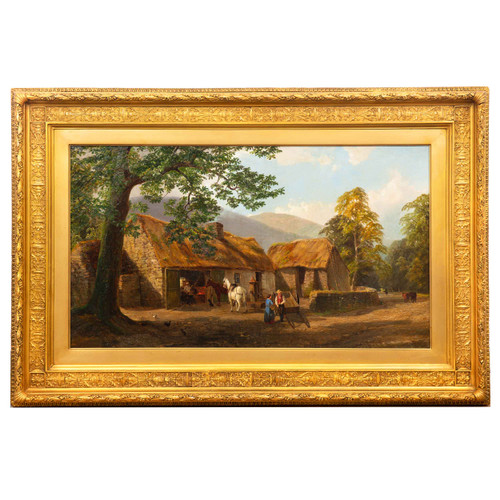catalog text
JOHN FAULKNER, R.H.A.
Ireland, 1830/35-1894
"The Smeltery"
Oil on canvas | signed lower left | original label verso titled "The Smeltery / John Faulkner R.H.A."
Item # 909KRP13
A wonderfully nostalgic glimpse into the past, this lovely large painting captures a beautifully detailed scene of the village blacksmith at work in his thatched-roof workshop with the fires of his forge roaring while he works the metal article on his anvil. A young man sits on a chair at the doorway watching him work in the glow of the fire while a couple outside chat beside an open cart, presumably waiting to collect some work they have dropped off with the smith. Note the exquisite texturing of the stones, the brilliant golden hay throughout the roofs and the chaotic grasses, stones and dirt of the yard and pathways. Moss grows along the outside of the large tree in the forefront, this casting a shadow across the yard and shading the chickens from the brilliant sunlit sky.
Remaining in fine original condition, not yet having the need to be relined and still on the original stretchers with a hand-inscribed label noting the title of the painting, it almost certainly remains in the original frame. Such a well-preserved piece is always a great pleasure to find.
JOHN FAULKNER, R.H.A. (IRISH, 1830/35-1894)
John Faulkner, born circa 1830 (depending on the reference text) in Dublin, Ireland, was a renowned landscape and marine painter, particularly noted for his atmospheric watercolor landscapes. His education in art began at the Royal Dublin Society School, where he studied drawing and fine art painting from 1848. Faulkner's exceptional talent was evident early on, leading him to exhibit his work at the prestigious Royal Hibernian Academy (RHA) by the age of 17 in 1852. His early works featured views of Killiney and the Wicklow coast, showcasing his skill in capturing the unique softness and dampness of the Irish climate, as seen in his watercolor of Slievemore, Achill Island.
Faulkner's career progressed rapidly; he became an associate of the RHA in July 1861 and was a full member by September of the same year. His scope as an artist was not limited to Ireland, as he traveled extensively, including to Scotland where he painted both mountain landscapes and seascapes on the western seaboard in Argyllshire. In addition to watercolors, Faulkner also painted in oils, and at 25, he shared a studio in Henrietta Street, Dublin, with fellow Irish artist Patrick Vincent Duffy.
However, Faulkner's life and career faced challenges including his expulsion from the Royal Hibernian Academy in 1870. This expulsion coincided with a period (1869-1880) where he did not exhibit any work, suggesting he may have been in America during this time, as evidenced by a painting of the Shenandoah Valley dated 1869. He returned to the art scene in the 1880s, settling in London while still occasionally making painting trips to Ireland. His later works included sea pictures, which are particularly noted for their liveliness and energy, such as ‘Cliffs at the base of Slievemore, Achill Island’ (1879). It was during these late years between 1884 and 1890 that he exhibited two landscapes at Suffolk Street Gallery, four at the Royal Academy and one at Grosvenor Gallery.
John Faulkner passed away in 1894, leaving behind a legacy of skillful and emotive landscape and marine paintings that continue to be admired for their depiction of the Irish and Scottish landscapes and seascapes. His paintings Loch Sheil and Slievemore, Isle of Achill are both held in the Manchester museum while Off Cape Slear is held in the Sheffield museum.
Artist Listings & Bibliography:
- E. Benezit Dictionary of Artists, Vol. V, Gründ, 2006, p. 502-503
- A Dictionary of Artists Who Have Exhihited Works in the Principal London Exhibitions From 1760 to 1893, Algernon Graves, 1973, p. 95
Measurements: 19 7/8" H x 33 5/8" W [canvas]; 30" H x 43 3/4" W x 2 1/2" D [frame]
Condition Report:
Surface carefully cleaned by our conservator - the former varnish layer had to be mechanically removed and for safety traces of grime have been left undisturbed in the lower recesses of the oil; behind the extreme edges of the frame the varnish has cross-linked with the underlying oil paint, though this is hidden by the frame; original stretcher bars and painting has not been relined, overall remaining stable with only minor age related craquelure; very slightly overcleaned in some areas with a tiny loss by the signature lower left; under UV examination: inpainted loss in the thatched-roof of the hut, a few speck touchups in the sky, overall the surface appears otherwise clear of notable inpainting though it is a bit difficult to examine thoroughly due to varnish flaring; original frame with extensive overpainting throughout. Presents beautifully - ready to hang.




























